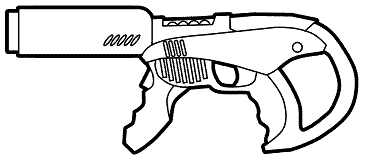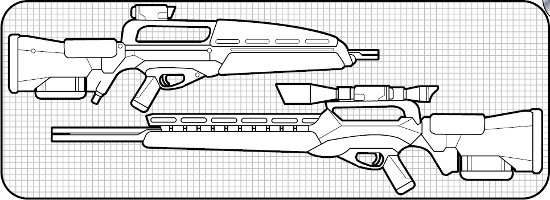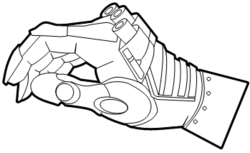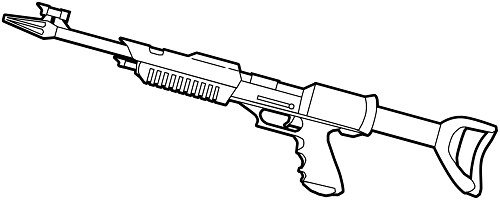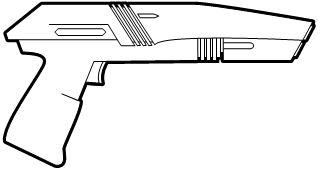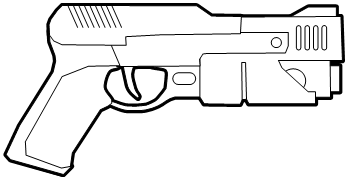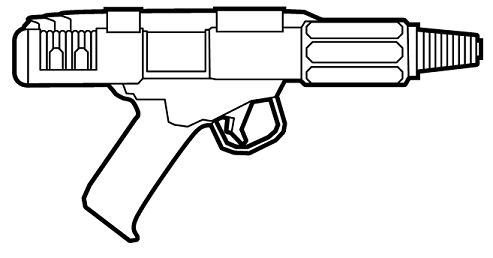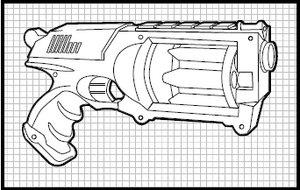AMMUNITION
Beam Weapon Ammunition
Powerclip. The standard 20 SEU powerclip is a
sturdy plastic box about the size of a cigarette pack.
A powerclip will fit any weapon that can use a
powerclip. Players must keep track of how many
SEU are in the clip. Powerclips can not be recharged.
Power Beltpack. A power beltpack is a 20 cm x 8
cm x 5 cm plastic box that attaches to a character's
belt. It comes with three different powercords that
can be plugged into three distinct outlets in the side
of the unit. One port is for weapons, one is for
screens and one is for auxiliary equipment such as
scanners or radios. Only one weapon and one screen can be plugged into a beltpack at the same time.
Beltpacks can be recharged at a cost of 5 credits per
1 SEU recharged. Recharging can be done at any
weapons shop, hardware store or fuel station.
Power Backpack. A power backpack is worn on a
harness that slips over the shoulders. Special
adapters are available for Dralasites at no additional
cost. A backpack has two weapon ports, one screen
port and three auxiliary ports. Only two weapons
can be connected to the same backpack. Backpacks
can be recharged for 5 credits per 1 SEU recharged.
It takes two turns to plug in or unplug a powercord
from a power backpack.
BEAM WEAPON AMMUNITION TABLE
Ammo Type
| Cost (Cr)
| Mass (kg)
| Energy/Rounds
|
Power Clip
| 100
| --
| 20 SEU
|
Power Beltpack
| 250
| 4
| 50 SEU
|
Power Backpack
| 500
| 10
| 100 SEU
|
Projectile Ammunition
Bulletclip. A bulletclip is a plastic, spring-loaded
rack of bullets, 5 cm x 2.5 cm x 15 cm. It holds 20
bullets for either an automatic pistol or rifle. Rifle
and pistol clips are not interchangeable.
Needleclip. A needleclip is a drum-shaped canister
10 cm in diameter and 5 cm thick, It holds 10
clusters of needles. Two varieties of needles are
available: barbed and anesthetic. Rifle and pistol
needleclips are not interchangeable.
Machine Gun Belt. Machine guns use a
disintegrating belt of 200 bullets (nothing is left of
the belt after all the bullets are fired except
individual shell casings). If someone is working with
the firer, ammo belts can be linked together so the
gun can keep firing without stopping to be reloaded.
Recoilless Rifle Shell. A recoilless rifle shell looks
like a 15 cm long artillery shell. It is essentially a
giant bullet.
Gyrojet Ammunition
Jetclip. Jetclips are loaded with 10 miniature
rockets. The clip is inserted into the weapon's ammo
chamber in front of the trigger. Pistol and rifle
jetclips are not interchangeable.
Grenade Bullet. A grenade bullet looks like a
shotgun shell. It is used to launch a grenade from a
grenade rifle. It has no effect if fired without a
grenade.
Grenade Shell. A grenade shell looks like a mortar
round. It must be loaded into a grenade mortar in
order to fire a grenade.
Rocket. Rockets are 25 cm long cylinders, with no
fins. The rocket’s exhaust is vented out the back of
the launcher when fired. Anyone standing directly
behind the launcher will suffer 5d10 points of
damage from the blast.
Archaic Weapon Ammunition
Arrows. Arrows can be bought in quivers that
contain 20 arrows. Characters with Environmental
skill can make crude arrows in an emergency.
Powder and Shot. One package of powder and
shot includes 20 lead bullets and enough black
gunpowder to fire them.
DEFENSES
Defenses
Security Skeinsuit
Security Skeinsuit
Cost 150Cr
Wgt 1kg
Energy 25 points
Defense Ballistic/Melee
Whereas the military skeinsuit is camouflage and appears very militant, and civilians who can afford it wear normal-looking clothes inlaid with the same protective layers, security personal tend to wear something in between. Local police, star law officers, and some espionage agents tend to purchase a security skeinsuit.
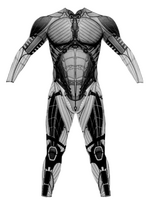
Security skeinsuits are function over form. They are not designed to help hide the character like a military suit, nor are they designed to conceal their existence, such as a civilian suit. Instead, they consist of overlapping layers of kevlar and other ballistic cloth. It is generally gray, occasionally black, and is light weight.
Security Skeinsuits protect against ballistic and melee attacks, just as a military or civilian skeinsuit does. Half the damage affects the wearer, the other half gets absorbed by the suit. The suit continues to help the wearer until it has absorbed 25 points of such inertial damage, then is too ripped up/damaged to continue protecting its wearers. This can happen pretty quickly, even in a small fight, so Security Skeinsuits are generally designed to require replacement after a good fight, thus their inexpensive nature.
Stealthskin
Stealthskin
Cost 80 Cr
Wgt 1kg
Sometimes direct protection against physical or energy damage isn’t as important as just avoiding detection. The best defense for an attack is simply not to be attacked.
Stealthskins are made of a special fiber that makes no noise when it rubs together. It is silent, even to the enhanced hearing of some races. Robotic devices or technologies with advanced hearing sensors will not even hear it rub together.
The Stealthskin is only effective when worn alone – no other clothes, no skeinsuit, no screen. When wearing the Stealthskin, the character is fully encased in a single piece of dark black fabric, stretching from top of his head to his toes. Even his face is covered. A single strip of specially-made non-reflective synthetic transparency runs across the eyes, allowing the wearer to see out quite easily. Many tiny stretchpockets exist along the thighs, waist, and arm, to give the wearer a place to place gear where it won’t rub or bounce or touch other equipment he carries.
The Stealthskin fabric is quite stretchy. It allows for the unusual shape-shifting abilities of a Dralasite to function normally. Additionally, the suite can be purchased to accommodate the wing membranes of a Yazirian or the unusual shape of a Vrusk, but when purchased for one of these other races it can only be worn by members of that species.
Benefits. When wearing a Stealthskin, the character is permitted to use the Stealth and Concealment subskills of the Environmentalist skill as if he were a Level 1 Environmentalist. If the character already has the Environmentalist skill, he can make amazing use of this fabric and gets a bonus of +10% to both of these skills.
If a character sustains more than 25 points of personal damage, or is encumbered with gear (carrying more than half his STA score in kilograms) the Stealthskin no longer provides these bonuses.
GENERAL EQUIPMENT
General equipment.
Autodoc
AUTODOC
Where is a dang medic when you need one? Are you tired
of having to hire medics all the time to keep adventurers
on the top side of the soil? Are you tired of their selfrighteous
know-it-all attitude? Who is a medic gonna call
when they get shot? Well look no further. Just dump your
shot-up buddy in the autodoc, and it will fix him right up.
Got a bad hangover? A sunburn? or even a dismembered
leg? Just hop in the autodoc. No job is too small or too big.
The Autodoc or "Coffin" is a level 6 autonomous medical
robot that can provide most services that a medical
professional can provide. The autodoc consists of an
airtight capsule, where the character is placed. It is
usually made of glass for observation. It also has built-in
storage for instruments and storage for drugs and gases
used during procedures.
USING THE AUTODOC
The injured or sick character is placed inside. The autodoc
assesses and diagnoses the problem. Then administers the
appropriate treatment. The autodoc will sedate the
character during treatment. They will be totally
unconscious during any procedures.
A character that has not gone below -30 stamina can be
placed in the autodoc. They will be stabilized and field
surgery will be performed. The auotdoc makes a skill
check for each treatment of skill level of 6. It will first do a
diagnosis. Then it will determine whether first aid, minor
surgery or major surgery is needed to heal the character.
Characters who are poisoned or infected: a skill check of
controlling infection then cure disease will be
administered. The character will not be released until all
Stamina points are restored.
A maximum of 20 stamina points per day can be restored.
The autodoc artificial intelligence can be convinced to
modify treatment or to release a patient early if there is a
legitimate reason. (i.e. The ship will blow up, or there is
another patient that will die.) Of course this is up to the
Referee’s discretion what type of logic or personality the
doc will have.
If the character has sustained a dismemberment of arm,
leg, finger, etc. the part can be put into the autodoc for
reattachment. Success on this varies.
If any skill checks fail for treatment the autodoc will
instantly put the patient in a freeze field. It will not release
the freeze field until the patient is brought to an advanced
facility for treatment.
Autodocs are species-specific or can be modified with
software and instruments for other races.
Autodocs can be used singularly or can be run in a
succession of several capsules. They were used to good
effect in the first Sathar war. The Marine carrier ship
Januus used an autodoc with a series of 200 capsules on
board for emergency battle treatment.
The autodoc will give a complete diagnostic of the
character in its care and give the time for treatment and
causes etc. It can also provide an autopsy of a dead
character. These are provided through voice or by
printout. The autodoc will converse with the characters to
discuss treatment (provide options, etc.).
POWER AND STRUCTURE
The autodocs usually have a constant power source (such
as a permanent installation, starship or a large vehicle),
although a parabattery or generator can be used. The
power usage is 20 SEU per day. The 'doc can be
temporarily disconnected from the main power source and
moved. Provided another power source is connected within
10 minutes. It is completely sealed and is insulated from
adverse weather and the vacuum of space.
The autodoc can withstand 100 points of damage before it
will not operate. If the doc has sustained damage the
capsule will remain locked. It will take a tech to defeat
security or another 30 points to the locking mechanism to
get at any patients.
MAINTENANCE
The autodoc must have a power supply to operate. The
autodoc can heal up to 500 stamina before it needs an
overhaul. This will cost 1,000 credits, and must be done at
a major hospital.
Autodoc. Cost 50,000, Extra capsules 10,000 (can add up to 10 capsules to one doc.), Comes with software for 1 species. Additional species programs and equipment are 5,000 ea. Size: 1.5 meters x 2.5 meters x 1 meter tall, Mass: 200 kg.
Duraraft
Duraraft
Cost 90 Cr
Wgt 3kg
This tiny 3kg pouch-sized kit can be inflated (automatically when activated) into a fully-functional four-man raft. It takes about five minutes to inflate, and a similar amount of time to deflate.
When deconstructed and properly stowed, it fits in a small pack that straps to the thigh for easy transport.
Envirotent
Envirotent
Cost 40 Cr
Wgt 3kg
This tiny 3kg pouch-sized kit can be erected into a small 3-man habitat tent in about ten minutes. It takes a similar amount of time to deconstruct. It can come in a variety of colors.
When deconstructed and properly stowed, it fits in a small pack that straps to the thigh for easy transport.
Jumpboots
Jumpboots
Cost 70 Cr
Wgt --
These appear to be a normal mundane set of boots, rugged-looking and easy on the foot. Concealed in the heel, however, is a tiny explosive charge.
When the wearer presses certain buttons on the boots, the charge becomes active. When the character jumps down hard on an active Jumpboot, the charge fires, and a concussive blast is heard for about a kilometer. The concussion launches the character into the air and improves his leaping distance by a multiple of 3. After the explosive blast, the boot acts as a normal boot. The charge cannot normally be re-set, it is part of the boots manufacturing process.
Using these boots in combat is not wise, both participants will be knocked 1d10 meters in opposite directions, and both will take 3d10 damage.
Mine Kits
by [[Larry Moore]]
Star Frontiersman #5-p1
These mine kits could be purchased for any type of grenade. Tangler mines are set in place and activated, then have special sensors (see below) to determine when they should detonate. They make fantastic perimeter defenses and non-lethal wards against intrusion.
A mine kit has two parts. First is the grenade itself, which mounts into the kit. Second is the sensory cluster, which act as the method of detonation (replacing whatever “delivery” type the grenade had previously). There are six basic types of tangler mine sensor clusters, as shown below:
Pressure Sensor – This is the standard, classic form of mine sensor cluster. It assumes the mine will be buried into the ground or under debris. It has a simple weight cell that relays analog weight levels back to a central processor, where it compares the detected weight against the sensitivity adjustment set during the setting of the charge. It takes 5 turns to dig, bury, cover, perform a weight tare, calibrate the setting, and conceal. Any creature equaling or exceeding the weight setting will detonate the grenade and be tangled. If desired, the mine’s detonation can be delayed 2 turns after the weight is released, in an attempt to entangle a larger group being followed by a party’s scout who set it off.
Proximity Sensor – This sensor can come in one of two forms: electromagnetic proximity sensor or laser-eye sensor. The electromagnetic sensor detects the presence of an electric field, either a bioelectric field generated by a living being or an activated defense screen (such as a sonic screen concealing the noises of an approaching intruder!). The laser-eye sensor is actually a beam and a receiver, which wirelessly reports data safely back to the mine central processor through a simple radio frequency transmitter/receiver pair. The mine will detonate if it detects the light beam is broken or the signal is somehow interrupted. It takes 2 turns to properly set and calibrate a mine equipped with a proximity-sensor cluster.
Motion Sensor – Using technology similar to the Motion Tracker (see this issue’s Equipment article), this sensor cluster detects movement in the proximity of the mine. It can be calibrated to filter out repetitive motion (such as rotating satellite antennae) and can even have filters put in place to define minimum and maximum speeds and sizes of detected motion. When the proper sized object or creature moves at the proper speed, it will detonate the tangler. It takes 2 turns to set and calibrate a filter array for a mine equipped with a motion sensor cluster.
Time Delay – Instead of a sensor, this cluster simply comes with a series of dials and buttons used to set a desired countdown. It can be set from 0 to 999 and can have hours, minutes, or seconds selected. Once selected and the “Initiate” button is pressed, the countdown begins. When it’s done, the grenade in the mine kit will be detonated. Although not commonly used with Tangler grenades, it certainly could be. It takes only a single turn to set a mine equipped with a time delay delivery cluster.
Photon Sensor – This type of sensor is set to detect either light or lack thereof, depending on the presence or lack of light in the turn directly following the turn in which it is set. Thus, if it is dark when the mine is set, the mine will detonate as soon as light becomes present. If it is light when the mine is set, it will detonate when darkness is detected. This can be used as a booby trap: simply place in a dark room near the door, and when the door is opened and the light in the hallway pours in, the person opening the door will be surprised. It takes only one turn to set a mine equipped with a photon cluster.
Voice Recognition Cluster – This very modern cluster has a programmable logic controller that is programmed by simple voice recognition pattern. Simple commands are used to set and define its operation. It is very expensive to purchase and is destroyed by the mine’s detonation (as are all sensor clusters). The character setting the mine simply speaks his command set to the mine “Mine. Activate. Motion Sense. One meter movement size. Ten meter minimum movement rate. One hundred meter maximum movement rate. Initiate.” Its operation can be set to do any of the above sensor cluster types. It’s also possible to set up exclusion rules (identification of friend or foe: IFF transponders) so allies never get affected. Voice Recognition Clusters are also quite difficult to defuse because they require programming knowledge to identify how they’ve been set. It takes only a single turn to set a mine equipped with a voice recognition cluster.
Mine Kit Equipment
|
Cost (CR)
|
Weight
|
Turns to set
|
|
Mine Kit* |
20
|
1kg
|
--
|
|
|
|
|
|
Sensor Cluster
|
|
Motion
|
40
|
1kg
|
2
|
|
Pressure
|
35
|
1kg
|
5
|
|
Proximity
|
45
|
1kg
|
2
|
|
Time Delay
|
25
|
1kg
|
1
|
|
Voice
|
150
|
1kg
|
1
|
|
Photon
|
20
|
1kg
|
1
|
* doesn't include grenade. Blast radius of 3 meters.
Survival Kit
Survival Kit
Cost 150 Cr
Wgt 6kg
This is an emergency survival kit. It is similar to the Standard Equipment Pack from the main rules book, but reformatted to make it useful for explorers and wilderness scouts (and anyone finding themselves stranded on a desert planet!). Many lifeboats and escape pods have a number of these survival kits stowed, as well as a single duraraft and envirotent.
The Survival Kit consists of the following items:
- All-weather blanket
- Basic first-aid equipment (bandages, etc.)
- Compass
- Everflame
- Gas Mask
- Holoflare
- Life Jacket
- Pocket Flashlight
- Pocket Tool
- Rope
- Sungoggles
- Survival Rations (5 days)
- Toxy-rad guage
- Waterpack
Visocom
Visocom
Cost 50 Cr
Wgt --
This is a hands-free version of the communicator built into a standard chronocom. It lacks any timekeeping technology, and attaches to a standard pair of sungoggles, magnigoggles, or Infra-red goggles. It has the same range as the chronocom (5km). Just like the chronocom, it has a standard identification number that can be given to others to enable them to “call” you.
To call another visocom or chronocom, simply touch a finger to the side of the boom mic/ear piece combination device, and clearly speak the identification number of the person you wish to call. It can also be put in a conference mode, where any number of visocoms and chronocoms can maintain an open channel for free communication among one another.
Visocoms are less expensive than their chronocom partners because they don’t keep track of time, are more obvious, and lack the micronization required to fit the technology into a wristwatch.
Wide-Field Recorder
Wide-Field Recorder
Cost 100 Cr
Wgt --
This sphere can hover and record all visual and audio activity in a 360 degree radius. It takes a standard 20 SEU clip and drains 1 SEU per hour. The recording is stored on a small micro-disc that can be read on most computer systems. A disc holds 20 hours of data, and extra discs can be purchased for 20 Credits. It comes in a shoulder worn carry bag complete with interface cables and a place to store 2 extra micro-discs and 2 extra SEU power clips. It cannot be connected to any other power source.
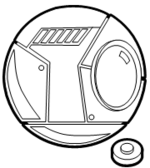
Later, when looking at the data recorded from the Wide-Field Recorder, a computer specialist can pan around, zoom in, filter out noise, and recreate the entire three dimensional experience recorded on the micro-disc. With proper holographic projection equipment, a fairly realistic scene can be reproduced.
Unfortunately, it is also possible for a skilled computer specialist to tamper with the data contained on the disc, making this device not admissible in most courts.
WEAPONS
Weapons and defenses.
Blastpistol
Blastpistol
Cost 200 Cr
Wgt 1.5kg
Damage 4d10
Ammo SEU
SEU 2
Rate 1
Defense Albedo
Range(PB/S/M/L/E) 5/15/-/-/-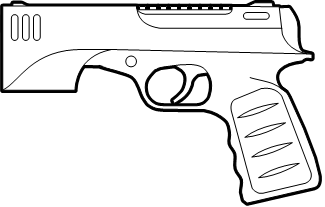
Not every world is so well equipped as the core worlds of the UPF. In fact, on the rim worlds, few beam weapon specialists are sporting the latest laser pistol. They carry a Blastpistol.
It’s a little bit bulky, doesn’t clear a holster quite quick enough, but it does pack a wallop. When fired, the energy from a standard SEU clip is focused through inexpensive crystal membranes (where some of the energy is wasted and dissipates in the form of heat). The energy releases in a rather large, nasty red blast that sounds thunderous rather than elegant. After the shot, there is a few seconds of high pitched whine while the crystal membranes perform a regeneration (thus the slow rate of fire for a beam weapon). It is not a stealthy pistol.
The blastpistol drains 2 SEU per shot, and uses a standard 20 SEU clip. It does not come equipped with a power port for the connection of an external beltpack or powerpack.
When holstered, the bulky nature of the end of the muzzle takes a little bit of effort to draw, causing an Initiative Modifier of -1 (in addition to the -3 penalty normally associated with holstered weapons).
An albedo suit or screen defends against the Blastpistol as effectively as it does against other laser weapons.
Electrostunner
| Weapon Name | Electrostunner
|
Skill Used
| Beam Weapons
|
Damage
| 4d10 or Stun |
| Ammunition | 20 SEU PowerClip, each shot drains 2 SEU. Can be attached to a Power BeltPack or Power BackPack. |
| Rate of Fire | 1 shot per turn |
| Defense | Gauss / Anti-Shock Implant |
| Range | 5/15/-/-/- |
| |
| Cost | 500 Cr
|
Mass
| 1kg
|
DescriptionAn electrostunner
looks like a large pistol. It is a short-range weapon. It fires an arc
of electrons that looks like a lightning flash. It is commonly called a
zapgun because of the noise it makes when fired.
An
electrostunner has two settings, stun and blast. A blast causes 4d10
points of damage. A stun can knock a creature unconscious for d100
turns. Anyone hit by a stun beam can resist the stun by rolling a
number less than or equal to its current Stamina.
A
zapgun
uses two SEU per shot. It holds a 20 SEU clip, but can also be
connected to a beltpack or powerpack with a 1.5 meter powercord. A
gauss screen will block the electrostunner's beam. An anti-shock
implant will nullify a stun but not a blast.
Gauss accelerators
Gauss (magnetic coil) technology is basically an electric
field that repulses an object. It then pulses to make the
object travel. High rates of speed can be obtained. Early
versions of gauss accelerators where in the form of simple
guns. They utilized a power source with a series of
capacitors to accelerate the projectile. These early
versions where severely limited by the ever increasing gap
needed between capacitors as the projectile increases
velocity. Also the imbalance in repulsor magnetism needed
as more power is applied.
The latest technology utilizes a pulsing inertia field that
pushes the projectile. The hardened projectile reaches
extreme velocities. This advancement made the concept of
accelerators much more reliable and efficient. In addition
the repulsor force field spins the projectile for stability.
The advantage of gauss rifles is that they have virtually no
recoil and a very high velocity. Up to 5,000 meters per
second, many times faster than conventional rifles. The
disadvantage is that the weapons require nearly as much
power in SEU to operate as a laser weapons, and still need
caseless projectiles.
The gauss rifle fires a small caseless projectile, 5mm.
which allows a high capacity clip. Due to the need for
ammo and a separate power source, there high cost and
being unreliable, gauss accelerator guns never reached
widespread use throughout the Frontier. They have seen
limited use by UPF marines.
When a gauss rifle fires there is no explosion of
gunpowder. Just a sharp crack as the bullet breaks the
sound barrier. Due to the hyper acceleration, the air that
is displaced is turned to plasma by the bullet. This effect
leaves a short red or blue streak trailing the projectile.
In spite of its drawbacks, gauss rifles are still encountered,
mainly used by collectors or eccentric sportsman. Their
armor penetration is unrivaled.
Note: a gauss rifle won’t fire from within an activated
gauss screen!
GAUSS ASSAULT RIFLE
Cost: 1500Cr
Weight: 4kg
Damage: 3d10 / 10D10
Rate: 3 (1)
Defense: Inertia
Range: 10/40/100/300/600
Ammo: 20 SEU/ 100 SHOTS CASELESS (50Cr)
Skill: Beam Weapons
Description: The gauss assault rifle uses 1 SEU per shot as well as a
bullet. Though it holds a 20 SEU clip, it is commonly used
with a SEU belt pack or a backpack. The magazine is
located rear of the trigger and handle, and is packed with
100 long, thin projectiles. The rifle can fire up to three
single shots per turn, fired independently (3d10 per
bullet), and can also fire bursts of ten bullets (which cause
10d10 and follow all the normal rules for firing bursts).
The scope mounted on it takes into account the ranges
given, so no bonus for scope.
On a roll of 96-00 the rifle has overheated and will not fire
for 1 turn. When firing a burst, the rifle’s coils overheat
on a roll of 90-00.
GAUSS SNIPER RIFLE
Cost: 2000Cr
Weight: 5kg
Damage: 4d10*
Rate: 1
Defense: Inertia
Range: -/70/200/500/1000
Ammo: 20 SEU/ 10 SHOTS CASELESS (5Cr)
Skill: Beam Weapons
* In the hands of a skilled character, a sniper rifle can be even more deadly. Military PSA characters can multiply their rolled damage by their Beam Weapons skill level, but only if two turns are spent aiming.
Description: The sniper rifle uses 2 SEU per shot as well as a bullet.
The sniper rifle holds a 20 SEU clip. It is does not have an
outlet for an SEU pack. The silent nature of the gauss
acceleration helps to keep the sniper hidden while
performing his art. The scope mounted on it takes into
account the ranges given, so no bonus provided for the
scope.
On a roll of 96-00 the rifle has overheated and will not fire
for 1 turn.
Gyrojet Wrist Rockets
Gyrojet Wrist Rockets
Cost 125 Cr
Wgt 1.5kg
Damage 2d10/bullet
Ammo 3 rounds
Rate 3
Defense Inertia
Range(PB/S/M/L/E) -/5/25/50/100
This durable pair of gloves each have a simple, gyrojet rocket rack on their backs that holds three gyrojet rockets. Characters wearing such weapons simply point their wrist, bend their hand down, and hit the dual trigger buttons to launch the rockets. This means they have to use one hand to fire the rockets on the other... it’s not possible with only two hands to fire both wrist rockets at the same time.
The rockets have slightly less range than a gyrojet pistol, but are otherwise quite similar. The owner of this weapon purchases pistol jetclips and disassembles them to extract the loose shells, and loads them into the chambers of the gloves. Reloading takes place after combat, as it takes several minutes to properly clean and replace the shells.
The wrist rocket is mounted on a polyplate gauntlet, giving it a really cool look and acting as brass knuckles in combat (causes 1d10 damage when punching).
Skeinsuits and inertia screens reduce gyrojet damage by half. If a skeinsuit and an inertia screen are used together, damage is reduced to one-fourth the amount rolled.
Some planets consider Gyrojet Wrist Rockets to be concealed weapons and have laws prohibiting their use. Most worlds consider it personal protection equipment, like a knife.
Laser Pistol
| Weapon Name | Laser Pistol ("Blaster")
|
Skill Used
| Beam Weapons
|
Damage
| 1d10 per SEU fired |
| Ammunition | 20 SEU PowerClip, each shot drains from 1 to 10 SEU, depending on the current power setting. Can be attached to a Power BeltPack or Power BackPack. |
| Rate of Fire | 2 shot per turn |
| Defense | Albedo |
| Range | 5/20/50/100/200 |
| |
| Cost | 600 Cr
|
Mass
| 1kg
|
DescriptionA laser pistol is a large handgun. It fires a pulse of bright light. Laser pistols are commonly called blasters.
A laser pistol has a dial that can be set from 1 to 10 to control how many SEU are fired by each shot. Each SEU fired causes 1d10 points of damage. For example, when the dial is set at 3, the shot uses 3 SEU and causes 3d10 points of damage. Players must tell the referee what setting they are using before rolling the dice to see if the shot hits.
Laser pistols use 20 SEU clips but can be attached to beltpacks or powerpacks. An albedo suit or screen halves the damage from lasers.
Laser Rifle
| Weapon Name | Laser Rifle ("Blaster Rifle")
|
Skill Used
| Beam Weapons
|
Damage
| 1d10 per SEU fired
|
| Ammunition | 20 SEU PowerClip, each shot drains from 1 to 20 SEU, depending on the
current power setting. Can be attached to a Power BeltPack or Power
BackPack. |
| Rate of Fire | 2 shots per turn |
| Defense | Albedo |
| Range | 10/40/100/200/400 |
| |
| Cost | 800 Cr
|
Mass
| 3kg
|
DescriptionA laser rifle is a rifle-sized version of the laser pistol. It fires a pulse of bright light. Laser rifles are commonly called blaster rifles.
A laser rifle has a dial that can be set from 1 to 20 to control how many SEU are fired by each shot. Each SEU fired causes 1d10 points of damage. For example, when the dial is set at 13, the shot uses 13 SEU and causes 13d10 points of damage. Players must tell the referee what setting they are using before rolling the dice to see if the shot hits.
Laser rifles use 20 SEU powerclips but can be (and usually are) attached to power beltpacks or powerpacks. An albedo suit or screen halves the damage from lasers.
Light Stunner Pistol
Light Stunner Pistol
Cost 150 Cr
Wgt 0.5kg
Damage Stun
Ammo SEU
SEU 4
Rate 1
Defense Gauss/AS
Range(PB/S/M/L/E) 5/10/-/-/-
First developed during the first Sathar War, and still in use by those agents of PanGal seeking brainwashed double agents, the Light Stunner is a great little weapon. Although it is less effective than the Electrostunner, its small size and concealable nature make it a great alternative.
Unfortunately, it is inefficient, and this is the reason it is not in widespread use among espionage agencies or megacorp security groups. Its inexpensive construction still gives it a place among the public.
It fires a bluish arc of electrons similar to the electrostunner, but smaller and even shorter range than its big brother. Military specialists snicker when they see the tiny gun, having nicknamed it the “zappy,” a cute shortened version of “zapgun,” which the electrostunner has come to be known as. Unlike the electrostunner, the Light Stunner can only fire in stun mode, it has no damage setting.
Whenever it fires, it drains 4 SEU from its source. Since it takes a 20 SEU clip, it can fire five shots before needing to be reloaded. The Light Stunner can be attached to a beltpack or powerpack with a 1.5 meter powercord. A gauss screen will block the beam, and an anti-shock implant will nullify the stun arc entirely.
Semiautomatic Pistol
Semiautomatic Pistol
Cost 150 Cr
Wgt 1.5kg
Damage 1d10/bullet
Ammo 20 bullets
Rate 3
Defense Inertia
Range(PB/S/M/L/E) -/5/25/50/100
These predecessors of the modern automatic pistols are functionally nearly equivalent. They fire bullets as quickly as the user can pull the trigger (up to three bullets per turn). There is no burst fire mode. The Semiautomatic Pistol uses the same ammunition and magazine as the modern automatic pistol. Skeinsuits and inertia screens reduce bullet damage by half. If a skeinsuit and an inertia screen are used together, damage is reduced to one-fourth the amount rolled.
Sonic Disruptor
| Weapon Name | Sonic Disruptor
|
Skill Used
| Beam Weapons
|
Damage
| 6d10/4d10/2d10/1d10
|
| Ammunition | 20 SEU PowerClip, each shot drains from 4 SEU. Can be attached to a Power BeltPack or Power
BackPack. |
| Rate of Fire | 1 shot per turn |
| Defense | Sonic
|
| Range | 2/10/20/40/-
|
| |
| Cost | 700 Cr
|
Mass
| 4kg
|
DescriptionA sonic disruptor is a type of rifle. It is commonly called a disruptor. A sonic disruptor generates a focused sound beam. The damage it causes depends on the range. At closer ranges, it causes more damage. It causes 6d10 at point blank range, 4d10 at short range, 2d10 at medium range, and 1d10 at long range. It has no extreme range. It uses a 20 SEU clip but can also be attached to a beltpack or powerpack. A disruptor uses 4 SEU per shot. Only a sonic screen can stop its deadly beam.
Sonic Stunner
| Weapon Name | Sonic Stunner
|
Skill Used
| Beam Weapons
|
Damage
| Stun
|
| Ammunition | 20 SEU PowerClip, each shot drains from 2 SEU. Can be attached to a Power BeltPack or Power
BackPack. |
| Rate of Fire | 1 shot per turn |
| Defense | Sonic / Anti-Shock Implant
|
| Range | 3/10/20/30/50
|
| |
| Cost | 500 Cr
|
Mass
| 1kg
|
DescriptionA sonic stunner is a type of pistol. It is commonly called a stunner. It will stun a victim for d100 turns. The victim can avoid the effect of the hit by rolling his current Stamina or lower. One shot uses two SEU. It uses a 20 SEU clip, but can be attached to a beltpack or a powerpack. A target with an anti-shock implant can not be stunned. Otherwise, only a sonic screen can stop the stunner's sound beam.
StunStick
Stunstick. A stunstick is a copper-colored tube 30
cm long and 3 cm in diameter, with an insulated
grip. It has two settings: shock and stun. When set
on shock, a successful hit causes 3d10 points of
damage. When set on stun, a successful hit will stun
the victim for d100 turns. A character can resist the
stun by making a successful check against his
current Stamina. A successful hit uses 2 SEU. A 20
SEU clip can be fitted into the handle, or the weapon
can be connected to a beltpack or powerpack. A
character with an anti-shock implant is immune to
the stun setting.
Tangler Gun
by [[Larry Moore]]
Star Frontiersman #5-p1
Although not common in the Frontier, the tangler gun is an extremely effective tool for law enforcement personnel and bounty hunters who prefer to bring them in alive rather than dead. It is a heavy pistol with a large fore-end, capable of firing tangler gelpacks that explode on impact, releasing their strands into the air, expanding and immediately beginning their hardening process.
The bullets fired by the gun are not hard, nor are they selfpropelled. They are gelatinous and encased in a tough outer plastic wrap designed to rupture on impact. The gun itself doesn’t fire through explosive means. No gunpowder or rocket fuel is used. Simple air compression is used, forcing air into the TanglerClip, causing the gelpack to be launched straight and true. The sound made by the tangler gun (as well as the general pneumatic nature of the weapon’s delivery of its payload) has earned the weapon the nickname “spitball.”
The weapon has a 20-SEU PowerClip in the handle, but this is simply to power the rapid air compressing pneumatic delivery system. The ammunition for this unusual weapon is the TanglerClip, which is a large cylinder with ten chambers, each with a tangler gelpack loaded into it with a thin plastsheet cover (to keep it from falling out when the gun is pointed downward). When the trigger is pressed, the PowerClip energizes the pneumatics and forces air into the chamber – breaking the plastsheet cover and launching the gelpack. The force of the air then rotates the cylinder clockwise to the next available cylinder. The weapon can be fired up to three times per turn in this manner. When the TanglerClip is depleted (10 shots), 1 SEU is drained from the PowerClip (it was drained gradually by firing those ten shots). When the PowerClip is depleted, the weapon can still be fired but must be pumped manually by pulling back on the top/back of the pistol. Pumping it in this manner builds up pressure without power, but reduces the rate of fire to one shot per turn.
Tangler Gun
Cost:
|
250Cr
|
|
Weight: |
2 kg
|
|
Damage: |
Entanglement
|
|
Ammo: |
10 shot TanglerClip
|
|
Rate: |
3 when powered, 1 when
manually pumped
|
|
Defense: |
RS Avoidance Roll
|
|
Range: |
5/10/20/40/80
|
|
Ammo Cost: |
25Cr (10-shot
TanglerClip)
|
|
Skill: |
Projectile Weapons
|
Yazirian Disc-Grenades
By [[Bill Logan]]
Star Frontiersman #5-p19
Yazirians have a keen sense of air currents and the weight
distribution of gliding and flight. Their air cars must look
like aerodynamic works of art – and probably handle like a
dream. Their weapon of choice? A disc-shaped dueling
blade that they hurl with both grace and precision. It only
makes sense that they would take their keen embrace of
the air and its usefulness to other technological
developments.
The Yazirian disc-grenade is a smallish discus (15cm in
diameter) with a curved outer lip. It’s able to be thrown
with a rapid motion flick of the wrist, hurling it forward to
ride on the air. It’s made of a lightweight plastic shell
with an inner core consisting of gunpowder and fragments
of steel and phosphors. It uses the thrower’s Thrown
Weapons skill, but can be used to throw around corners
and bounce off certain solid surfaces in order to get it to
where the thrower desires. In the right hands, it can get
around defensive barriers.
The grenade inside the core will detonate on impact.
Therefore, when bouncing the disc-grenade off solid
surfaces, it’s important for the thrower to understand the
limits on how hard one can strike a wall with it without it
exploding. Experience and practice is best, with training
dummy disc-grenades being half the price of a normal
one.
Yazirian disc-grenades can be purchased in any location
where normal grenades are sold, as long as it’s a world
with a notable Yazirian population. They’re quite common
on Gruna Garu and sites decidedly Yazirian. Clan
markings are often placed on these devices, left as a
calling card in clan politics.
| Type of throw | Penalty |
| Simple, normal throw | +0 |
Impressive throw
(difficult air currents, rain, etc.) | -10 |
Challenging throw
(throwing around an obstacle or bouncing
once off a wall) | -20 |
Complext throw
(using air currents to make complex aerial
flight path, or bouncing off multiple
obstacles) | -30 |
Heavy Laser
| Weapon Name | Heavy Laser
|
Skill Used
| Beam Weapons (-10 to hit) |
Damage
| 1d10 per SEU |
| Ammunition | 20
SEU PowerClip, each shot drains from 5 to 20 SEU, depending on the
current power setting. Can be (and usually is) attached to a Power BeltPack or Power
BackPack. |
| Rate of Fire | 1 shot per turn |
| Defense | Albedo |
| Range | -/100/500/1km/2km |
| |
| Cost | 6,000 Cr
|
Mass
| 20kg
|
DescriptionA heavy laser is about the size of a machine gun. It must be mounted on a tripod or a swivel mount to be fired. It has longer range than a laser rifle, and a minimum SEU setting of 5. Otherwise it operates the same as the laser rifle.
Note: Heavy lasers are heavy weapons. When a character fires a heavy weapon, he must subtract 10 from his chance to hit.

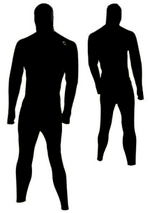
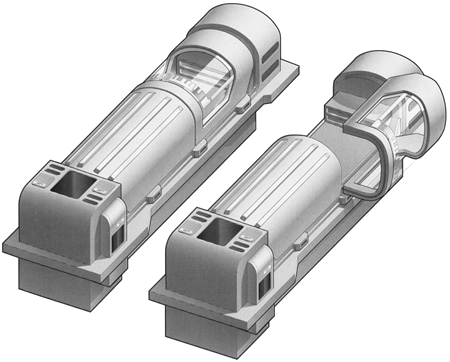
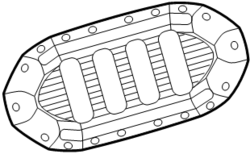
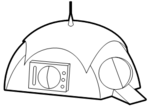
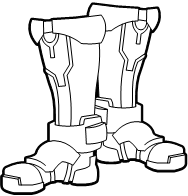
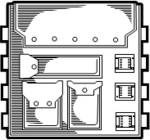




 Not every world is so well equipped as the core worlds of the UPF. In fact, on the rim worlds, few beam weapon specialists are sporting the latest laser pistol. They carry a Blastpistol.
Not every world is so well equipped as the core worlds of the UPF. In fact, on the rim worlds, few beam weapon specialists are sporting the latest laser pistol. They carry a Blastpistol.